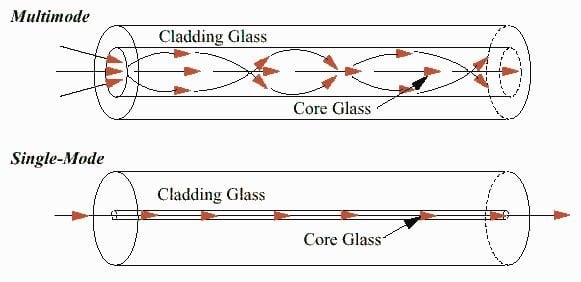When utilizing optical fibers for high-speed communications applications, there two primary categories that fibers are grouped into, based on their construction and intended applications. In this article, we will review both Single Mode and Multimode optical fiber classifications, providing a quick introduction to both types and their key differences.
Multimode Optical Fibers
Multimode optical fibers are designed for light transmission in the 800nm-1300nm wavelength range using VCSEL lasers. Constructed with a larger diameter glass core size of either 50um or 62.5um, they allow for multiple modes of light to propagate within the fiber. However, the resulting modal dispersion significantly reduces the signal quality as the distance increases, so this type of fiber is used for many short-distance applications of less than 1000m, but typically 600 meters or less.
Because of the distance limitations, multimode fibers have been widely deployed for applications inside buildings or between sites of close proximity like campus networks, data centers, municipal complexes, Local Area Networks (LAN), and so on.
While the original multimode fibers utilized the 62.5um core size (OM1 standard) which allowed for 1G (275m) or 10G (33m) transmission, in more recent years, laser-optimized multimode fibers with the 50um core were developed that allow for higher data rates over longer distances as system speeds have increased. As an example, OM3 allows for 10G (300m), 40G (100m) and 100G (70m) respectively, with newer OM4 and OM5 fibers offering even greater performance.
Examples of popular multimode fibers include the Corning® ClearCurve® series and the OFS® LaserWave® Flex series, however, there are multiple types offered from an array of manufacturers that offer various specifications or address specific applications.
Single Mode Optical Fibers
Different from multimode fibers, single mode fibers are designed for light transmission at higher wavelengths typically in the 1260nm to 1625nm range. Constructed to have a much smaller glass core size of just 9um, they allow only a single mode of light to propagate within the fiber, but the small core size helps to reduce dispersion and allows significantly longer transmission distances to be achieved. Single mode fiber can and is utilized in networks with distances ranging from just a few kilometers to hundreds or even thousands of kilometers.
Due to the performance characteristics and longer distances for which single mode fiber can be used, it is deployed for a wide range of local, metro, regional, and transoceanic networks including but not limited to Telecom, Cable TV, Data Center / Cloud, Financial, Web Service Provider, and Government systems.
Within the single mode category, there are several types by industry standard, catering to specific applications or performance objectives. As an example, the ITU-T G.652D spec is "standard single mode" which is the most widely deployed fiber type around the globe, however other specs like G.654 and G.655 provide enhanced characteristics like low attenuation for transoceanic applications and low dispersion for long-haul applications respectively.
A few examples of the most popular standard (G.652D) single mode fibers include Corning® SMF-28® Ultra, OFS® AllWave® One, and Prysmian® ESMF. Similar to multimode, these and other manufacturers all offer a large selection of single mode fibers to meet the various industry specifications and applications that exist.
Diagram: Light Transmission - Multimode vs Single Mode Fiber

Image Credit: www.sdvoe.org
Learn More
Download a free copy of the 2021 Optical Fiber Reference Guide from M2 Optics that includes a current, extensive list of the most popular optical fibers from leading global manufacturers along with their technical data sheets:







